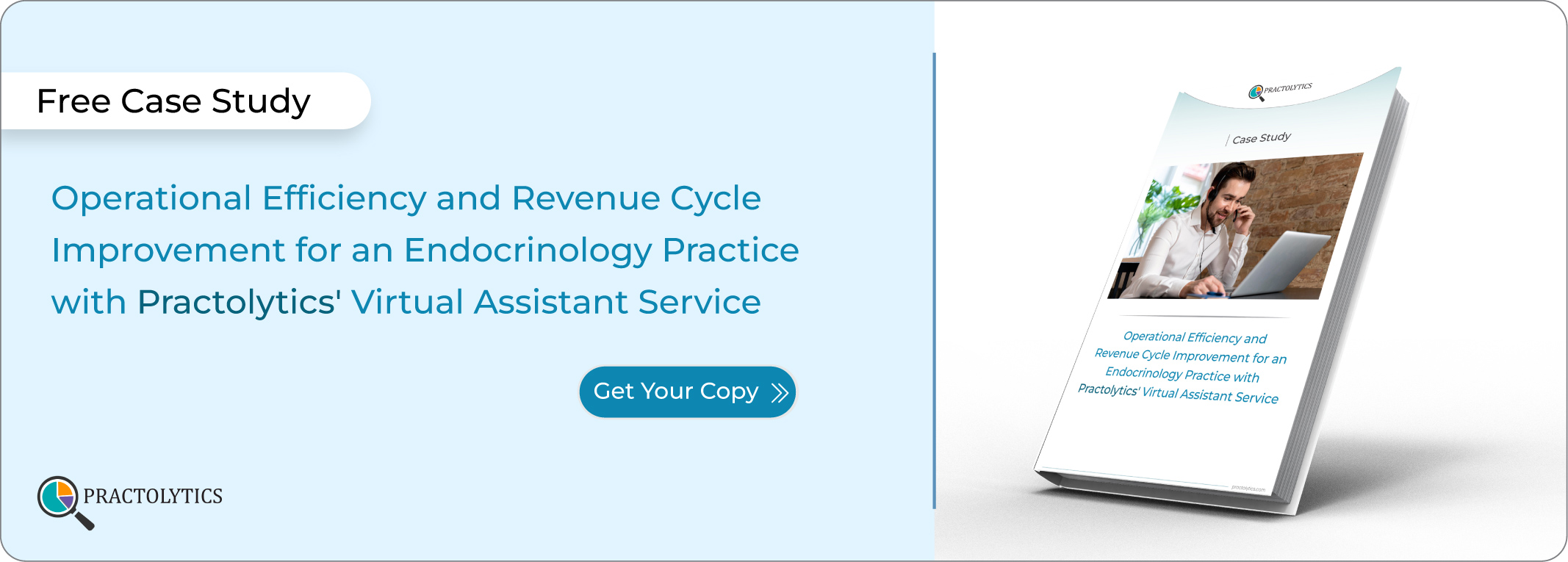Rise of Virtual Medical Assistants in Modern Healthcare
Technological improvements are part of the modern healthcare environment. Changing demands and ongoing labor shortages are also part of the modern healthcare environment. Doctors and practice management are always looking for new and creative ways to increase patient involvement. They also seek to reduce administrative workloads and maintain financial viability. The Rise of Virtual Medical Assistants in modern healthcare has emerged as a driving force that will impact practice operations in 2025, in addition to being a temporary fix in this complex environment.
Healthcare Virtual Medical Assistants are highly skilled individuals who work remotely to help healthcare practitioners administratively and occasionally clinically. They operate remotely and effortlessly integrate into your workflows using safe digital platforms, acting as an extension of your staff. Their ascent reflects a larger trend in healthcare toward digital transformation, remote employment, and the strategic outsourcing virtual medical assistant services of non-core tasks.
In addition to discussing the difficulties that practices must take into account for a successful integration, this blog post will examine the strong advantages that have contributed to the quick uptake of virtual medical assistants in 2025.
Table of Contents
Virtual Medical Assistants Advantages in 2025
In 2025, VMAs will be popular because they can solve a number of important issues for healthcare professionals, including:
1.Significant Cost Savings and Scalability
The significant cost savings that comes with employing a VMA is among the most noticeable and immediate advantages. In-house staff come with salaries, benefits (health insurance, PTO), payroll taxes, office space, equipment, and training costs. Virtual Medical Assistant Companies, particularly those sourced from specialized agencies, offer:
- Decreased Overhead: Get rid of costs for electricity, equipment, and actual office space for a new hire.
- Reduced Labor Costs: When using international talent pools,Medical Assistants can frequently be hired for a fraction of the price of a full-time, in-house medical assistant.
- Absence of Employee Benefits: Agencies usually take care of its VMAs’ benefits, relieving your practice of that responsibility.
- Scalability and Flexibility: Do you require more assistance for a particular project or during busy times? VMAs offer flexible help without the long-term commitment of a regular employment because they can be ramped up or decreased as needed. This adaptability is crucial in hectic medical environments.
2.Boosted Practice Efficiency and Productivity
Virtual medical assistant are excellent at managing tedious, repetitive administrative duties, freeing up your own staff to concentrate on more valuable work and provide direct patient care. Their capabilities often include:
- Scheduling, rescheduling, automated reminders (text, email), and cancellation handling are all part of appointment management’s strategy to lower no-show rates. Many are able to operate around the clock and accept reservations outside of usual business hours.
- Patient involvement and communication can be demonstrated through various methods. Examples include answering questions, advertising clinic hours, and providing instructions via phone, email, or chat. They can offer pre-visit instructions. They can also offer prescription reminders and follow-up notes.
- Entering test findings accurately, updating medical records, transcribing notes, and entering patient information are all examples of EHR data entry and documentation. Some advanced VMAs can even perform real-time medical scribing during telehealth visits.
- Verifying patient eligibility and benefits, starting prior authorization requests, and monitoring their progress are all part of insurance verification and prior authorizations.
- Support for Basic Medical Billing & RCM: Helping with basic coding inquiries, claim preparation, and preliminary follow-ups on unpaid claims.
- Referral management is the process of organizing specialist referrals and making sure that the required paperwork is sent out.
- Clinical personnel will be more productive and less tired if these tasks are delegated, freeing up more time for patient care, which is their specialty.
3.Enhanced Patient Experience
Today’s patient-centered healthcare approach relies heavily on ease of use and effective communication. To improve the patient experience, VMAs are required:
- Patients can receive help whenever it’s convenient. This is possible thanks to round-the-clock scheduling and simple question answering.
- Patients experience less waiting and annoyance when questions are answered promptly. Administrative duties are processed effectively.
- Personalized communication helps patients feel appreciated. It involves providing pertinent information, follow-ups, and reminders.
- Decreased wait times are a benefit of streamlined administrative procedures. These procedures also lead to more concentrated contact with healthcare staff.
4.Specialized Expertise and Skill Sets
Virtual Medical Assistant providers often offer access to a pool of professionals with diverse skill sets and specialized training. This means you can find VMAs proficient in:
- Numerous VMAs has prior training and proficiency in a range of EHR systems. These systems consist of Epic, Cerner, and Athenahealth.
- They are aware of HIPAA rules and medical terminology. They also understand healthcare compliance standards.
- Bilingual VMAs can improve communication with a range of patient demographics. This is because they provide access to multilingual versions.
- This specialized expertise can be a major advantage, allowing practices to fill specific skill gaps without extensive internal training.
5.Focus on Core Clinical Operations
Healthcare practitioners’ time is freed up when administrative duties are delegated to VMAs. This enables them to concentrate on giving patients top-notch care. Physician burnout may be avoided with this modification. It can also increase internal staff job satisfaction and facilitate more strategic planning and practice expansion.
Challenges of Integrating Virtual Medical Assistants
Despite the obvious advantages, incorporating VMAs is not without its difficulties. For this transformation to be successful, practices need to tackle it strategically.
1.Data Security and HIPAA Compliance
Data security and patient privacy are the most important considerations when working with any remote team.
It can be difficult to guarantee complete HIPAA compliance for VMAs and the platforms they utilize. Persistent problems include misuse of protected health information, illegal access, and data breaches.
Solution: Only collaborate with respectable VMA service providers who exhibit strict security measures. Secure remote access using VPNs, multi-factor authentication, regular security audits, thorough HIPAA training for all VMAs, unambiguous Business Associate Agreement contracts, and robust encryption are a few of the examples.
2.Communication and Coordination
For remote teams, effective communication techniques are essential. They enable remote teams to work together. They work together efficiently.
Challenge: Communication preferences and time zone differences can lead to misunderstandings. Delays in in-person interactions may potentially be the cause of this. Making ensuring VMAs fully integrate could be difficult. They could struggle to understand the nuances of their profession.
Create routes of communication that are clear. For daily meetings, use video conferencing and secure texting tools. Assign tasks efficiently. Create avenues for input and conduct routine follow-up. To guarantee that VMAs comprehend practice methods and culture, provide thorough onboarding and continual training.
3.Integration with Existing Systems
VMAs must work in unison with your current practice management software, electronic health record, and other online resources.
Challenge: Compatibility issues between VMA platforms and your current systems. A steep learning curve for VMAs if they are unfamiliar with your specific software.
Solution: Select Virtual Medical Assistant or Virtual Medical Assistant service providers with a wealth of knowledge about the main EHR systems. Make sure they know how to swiftly adjust to new software. To ensure a seamless integration, budget for both initial training and continuing technical assistance.
4.Quality Control and Performance Management
A distinct strategy to supervision is necessary to guarantee a remote team produces work of consistently high quality.
The challenge is to keep an eye on performance, guarantee accuracy, and give useful feedback in a virtual setting. Variability in virtual health assistannt performance if not properly managed.
Solution: Implement clear Key Performance Indicators (KPIs) for medical assistant tasks. To monitor effectiveness, make use of the reporting options in practice management software. Audit their work on a regular basis (e.g., charting correctness, claims submission). Give regular instruction and constructive criticism. Reputable VMA organizations frequently have their own procedures for quality control.
5.Managing Expectations and Cultural Fit
Introducing a remote, outside team into your practice might occasionally result in unanticipated difficulties with team relationships.
Challenge: The inclusion of healthcare virtual assistant has left internal workers feeling intimidated or overburdened. Potential for a perceived disconnect or lack of “team spirit.”
Solution: Clearly communicate the role of Virtual medical assistants to your existing staff – emphasizing that they are there to support and alleviate burdens, not replace roles. Encourage teamwork. Seek out VMAs that can easily fit into the culture of your practice and who are not just skilled but also have excellent interpersonal and communication abilities.
Conclusion:
The unquestionable importance of virtual medical assistant services in assisting healthcare practices in navigating the intricacies of contemporary operations is demonstrated by their rise in 2025. VMAs have strong benefits, ranging from substantial cost reductions and increased productivity to better patient experiences and scalability.
But achieving these advantages calls for a calculated strategy. Data security must be given top priority in practices, along with the establishment of strong communication protocols, smooth system integration, and efficient performance management. Healthcare providers can effectively use virtual medical assistants to streamline workflows, lessen administrative burden, and ultimately concentrate on providing outstanding patient care in the years to come by thoroughly screening VMA partners and anticipating and resolving any issues. In the undoubtedly hybrid future of healthcare workers, VMAs are leading the way.
By 2025, virtual medical assistants, or VMAs, will be crucial in tackling the persistent issues facing the healthcare industry, such as a lack of employees, growing operating expenses, and excessive paperwork. These highly skilled experts assist with scheduling, EHR documentation, insurance verification, billing, and patient interaction while working remotely. By simplifying processes and providing round-the-clock assistance, VMAs dramatically lower overhead expenses, boost productivity, and improve patient happiness. They are an invaluable asset to any practice because of their specific skill sets and experience with the main EHR systems. But careful planning is necessary for a successful integration, guaranteeing alignment with current systems, efficient communication, and HIPAA compliance. Strategically deployed, Virtual medical assistant for providers helps in minimizing burnout, refocusing on essential clinical activities, and adjusting to a more adaptable, technologically advanced healthcare environment.
Read More – From Chaos to Efficiency: A Small Practice’s Journey with a Virtual Assistant
Talk to Medical Billing Expert Today — Get a Free Demo Now!






